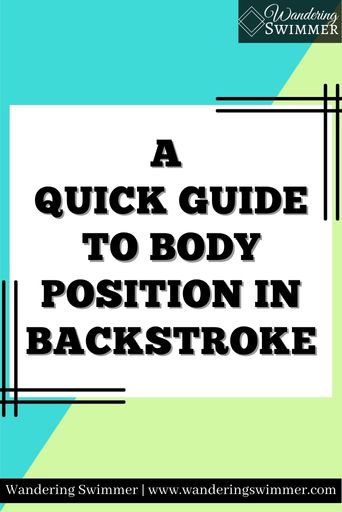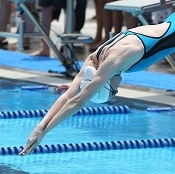The backstroke is one of two swimming strokes that’s swum on the back, hence the name! However, there’s more to the body position in backstroke than just floating on your back.
Related article: The Beginner’s Guide to Swimming Backstroke
Learning how to swim backstroke with good body position can make swimming much easier. Just as proper body position is the starting block to learning how to swim backstroke. Much of the stroke stems from how you hold your body in the water.
It may also help prevent injury, especially as it pertains to neck soreness if you’re holding your head incorrectly.
Disclosure: This post may contain affiliate links, meaning we earn a small commission at no cost to you if you purchase something through one of our links. As an Amazon Associate, we earn from qualifying purchases. Please check out our disclosure page for more information.

Body Position in Backstroke
The backstroke body position starts with you floating on your back in the water. This means your face will be out of the water and facing the ceiling. Making it much easier to breathe!
Your body should be almost flat and near the surface of the water when swimming backstroke.
We say almost flat because:
- The rotation in backstroke means that you’re never truly swimming on your back
- Some swimmers can get their shoulders up and out of the water when they rotate, while others may only rise slightly
- And because some swimmers may find a slight tilt in their hips that pushes their legs down about 1-2 degrees
Again, slightly. You shouldn’t look like a steep diagonal line where your hips and legs are sinking. Instead, it should be only the barest amount of incline. This small incline can make it easier to kick.
Related article: How to Kick in Backstroke
You should have the slightest crunch or bend at the hips. And we do mean slight! Too much bending at the hips will make you lose balance in the water and you’ll start to sink.
I’ve had coaches reference that you’ll look like a frozen banana or a boat.
In the same way that a banana or a boat has a slight curve to them, so too should your body. This will help you find balance and swim easier.
Head Position in Backstroke
In backstroke, your head should always be flat and in a neutral position.
When swimming, the water should be hitting right at the top of your head. You shouldn’t be tilting it forward to look at your feet. Just as it shouldn’t be pressing back into the water so that it dips below the water.
Instead, it should remain flat and look straight up towards the ceiling or sky, depending on where you’re swimming 🙂 In many ways, it’s no different than if you were lying in bed on your back!
Keeping your head in this neutral position is important for two reasons:
- It keeps your body balanced and makes it easier to hold a horizontal position
- Doing so greatly lessens the strain placed on your neck and shoulder muscles
We will note that even though the body rotates in backstroke (covered next), the head itself doesn’t move or rotate with the body.
It continues to stay still and in a neutral position.
If you find that you’re struggling with keeping your head still, you can try swimming with a water bottle on your forehead. Coaches use this common drill to help you see if you’re moving your head when you swim backstroke.
Concerns About Running into Things/The Wall
Probably one the biggest reasons swimming backstroke is so hard for people is because they want to look around or up when they’re swimming. Mainly because they’re worried about hitting something.
And we get it! You’re on your back and you can’t see where you’re going. It’s enough to make anyone worried.
But if you start looking around while swimming, you’re more likely to weave all around when you’re swimming. And that makes you more likely to hit something.
Instead, it’s better to keep your head tilted back and watch for the backstroke flags so you don’t hit the wall. If needed, you can tilt your head to the side just enough to watch the lane line so you can keep in a straighter line.
If you’re swimming backstroke outside, we do recommend outdoor goggles, such as AquaSphere (Kayenne version). I prefer Arena Tracks for my goggles. They also offer goggles specifically for outdoors, such as this version (white/smoke/green).
Concerned about hitting your head and/or trying to swim a straight line? We cover this more in our companion article: How to Avoid Hitting Your Head When Swimming Backstroke.
Rotation of the Body in Backstroke
While the body position in the backstroke is horizontal in the water, that doesn’t mean it stays flat. As mentioned before, your torso and hips rotate in the backstroke.
This rotation occurs as the arm is getting ready to leave the water and the body is rolling toward the side of the arm out of the water (recovery arm).
To put it simpler, the arm that’s coming out of the water should be the shoulder that’s rotating out of the water. The body will be rotating or rolling in the direction of the arm under the water.
Related article: All About the Backstroke Arm Movement
For example, if you’re right arm is exiting the water, your torso will be tilting towards the left. And vice versa 🙂
How much of a rotation though varies by the swimmer. If you ask swim coaches, they’ll say that most of their swimmers don’t rotate enough.
In theory, your rotation should be enough that your shoulders come out of the water during the stroke portion of the backstroke.
However, for swimmers of any experience, this can be difficult because it’s easier (mentally, at least), to ignore the rotation of the shoulders.
Physically, it seems like it may take more energy, but I’ve found that it only takes more energy when I’m trying to go fast. It’s very easy and relaxing when I’m swimming at an easy pace.
Common Questions About Body Position in Backstroke
Do The Hips Rotate in Backstroke?
They do! Just like in freestyle, the hips will rotate from side to side as you swim backstroke. Your hips should never stay exactly flat in the water and even a small amount of rotation is better than none.
However, some swimmers may rotate their hips more than others in the backstroke.
These types of swimmers may have a strong kick that can help increase their speed and tempo, helping them go faster. Even if their arms appear to go slower than other swimmers.
Related article: Common Backstroke Mistakes
For swimmers such as this, their backstroke is driven more by the rotation of their hips and their kick than swimmers who use their shoulders to drive the rotation.
Which is better?
It varies by the swimmer and the distance you’re swimming. If you struggle with kicking, hip-driven backstroke probably isn’t the best option for you. And it would be better to work on your shoulder rotation.
That said, even swimmers who focus more on shoulder rotation to drive their backstroke should ensure that their hips have some rotation. The rotation in the hips can help further the rotation in the shoulders.
How Do I Stop My Hips/Legs from Sinking?
Probably one of the biggest issues with backstroke is that your hips and/or legs are sinking in the water. When this happens, your legs begin to pull your body under with them.
This not only makes it difficult to swim but also forces your head underwater after a while.
Related article: 8 Backstroke Kick Drills
For some people, this happens due to technique. It may occur for others though due to body mass. Some swimmers with heavier and dense muscles may have trouble floating naturally in the water.
It doesn’t mean that these body types can’t swim backstroke or float on their back. But it may take a bit more effort to keep the body afloat.
Your hips and legs can sink for a few reasons.
Your Head is Lifted Up
If your head is tilted forward and you’re looking down toward your feet, it can impact your balance. Like a see-saw, as your head lifts up your legs must go down.
Instead, you’ll need to lean it back and rest it in the water. You should be looking up towards the ceiling or sky. Doing this will help keep your legs from sinking.
Bicycle Kicking
If you’ve read our series on the freestyle stroke and the flutter kick, you know that bicycle kicking is a pet peeve of mine as it pertains to swimming.
Bicycle kicking in swimming happens when you bring your knees up to your hips and push them back in the water. Like you’re trying to peddle a bike in the water. Hence the name 🙂
If you’re floating in the water and bring your knee up to your hip, what do you think happens? It throws you off balance and causes issues with your body position in backstroke. And when you lose balance in backstroke, your legs start to sink.
This is especially true while bicycle kicking, as you’re bending at your hips to help bring your knees up. Your body will have no choice but to send your legs vertical, if not your whole body.
Remember that the flutter kick is an almost straight leg kick. Your knees have a slight bend but no more than you would bend them to walk. The kick should start from your hips, not your knees.
Do I Keep My Shoulders Out of the Water in Backstroke?
Not in the way the question is asking 🙂 It’s not so much that you keep your shoulders out of the water as it is equal parts rotating your shoulders out of the water and keeping them on top of the water.
You shouldn’t feel that you need to hold your shoulders out of the water. The rotation piece of backstroke will take care of that for you. Again, the degree of rotation will vary by the swimmer.
But, so long as you’re rotating, you should get some amount of your shoulder out of the water. We cover a few drills in Drills to Help You Master the Backstroke that focuses on rotation.
Your shoulders should also be on top of the water. We say this because it makes it easier to rotate out of the water when they’re already on or near the top of the water. Again, you’re not holding the shoulders out of the water. Rather, they should be resting just on or at the surface.
In Closing
The most important takeaway from your body position in the backstroke is that your head should be back and your body high in the water. Doing both of these helps set up your rotation, which in turn assists with your stroke.
In swimming, every piece in the stroke is connected somehow. Start with a good body position and the rest will follow!
As always, happy swimming!
Chevron
Bonus Content
Basic Swimming Terminology: Knowing some swimming terminology, or swim terms, will help you navigate the swimming world. Here are 25 common swimming terms to get you started.
6 Best Earplugs for Swimming: Tired of water in your ear or looking to prevent swimmer’s ear? One of the best solutions to prevent this is to get you a good set of earplugs for swimming. Here’s everything you needed to know about picking the best swimming earplugs for you.

Want to Improve at the Pool?
Join swimmers and swim parents to receive my free newsletter and receive a free Swimming Glossary e-book as a thanks!
Every month you’ll receive tips and coaching to help you find success at the pool.
About

Chevron is a current competitive swimmer with almost 20 years of experience in the pool. And although she fell into the sport by accident in her high school years, she still trains daily and competes throughout the year. She’s committed to providing guidance to all levels of swimmers and believes that everyone should know how to swim. Keep Reading